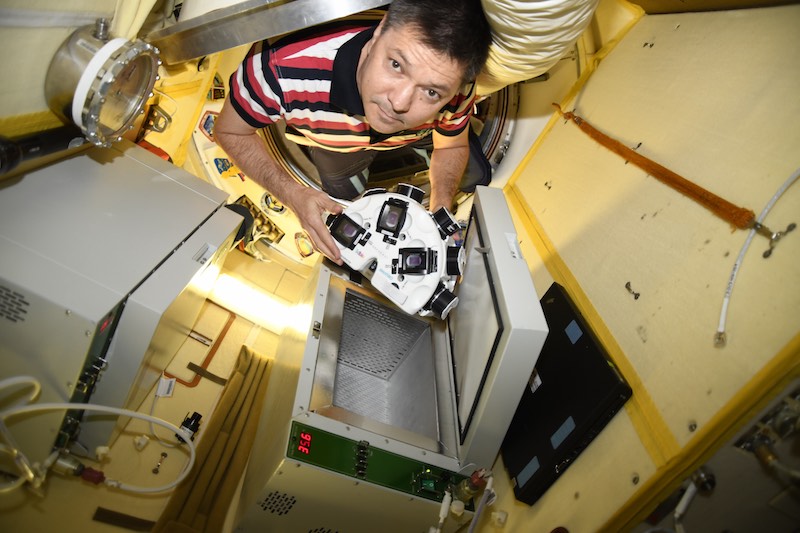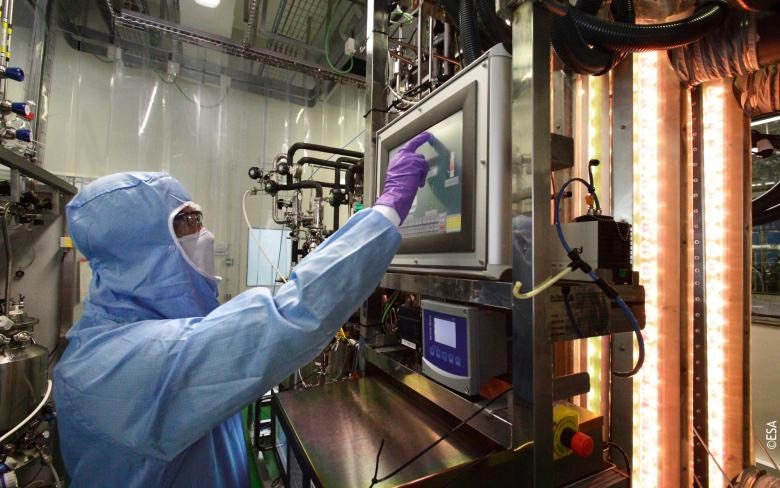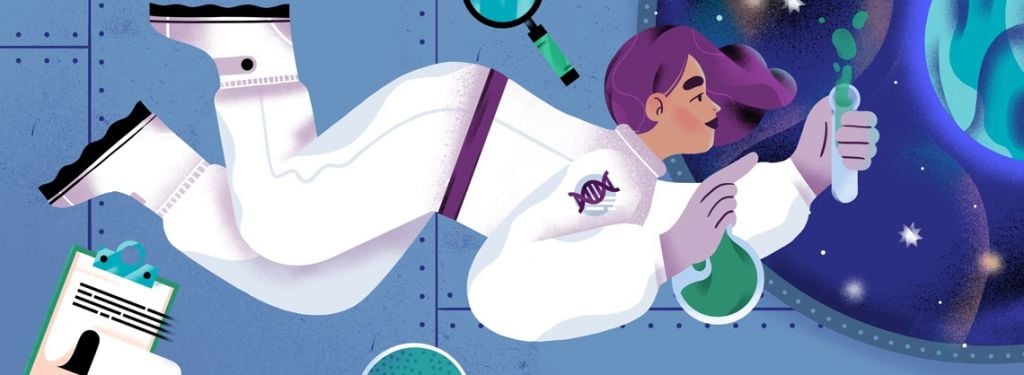Newsletter Signup - Under Article / In Page
"*" indicates required fields
This article was originally published in March 2019 and has been updated to reflect recent developments.
As we prepare for long-distance space travel and life on Mars, biotechnology will be essential to make spaceships no longer dependent on Earth’s constant supply.
“As human beings, we need a constant supply of oxygen. We need constant access to nutritious food, clean water and a safe and clean waste disposal system,” says Italian astronaut Samantha Cristoforetti. While she talks, her watch is floating on her wrist. She is doing a livestream from the International Space Station (ISS).
Cristoforetti explains that the ISS recycles most of its water, collecting it from the air and from astronaut urine. The station can also produce some of its oxygen from water. However, it still needs a constant supply of oxygen, water, food and medical supplies from Earth to keep astronauts alive.
“But what happens if human beings want to travel further into deep space, far away from Earth, where we cannot rely on a constant resupply?” she asks.
Establishing a base on the Moon or taking humans to Mars for the first time is a goal of several countries around the world — and of billionaires. Jeff Bezos’ firm Blue Origin is already fighting Elon Musk’s SpaceX to send NASA missions to the Moon. Meanwhile, Elon Musk aims to take us to Mars.
“To be able to survive a long-term mission, you need to transport a lot of water, a lot of food and a lot of oxygen,” says Christophe Lasseur, R&D Coordinator at the European Space Agency (ESA). “For a Mars mission, it would be somewhere in the order of 30 tons. Today, this is too heavy for the launchers.”
All around the world, scientists are working hard to address these challenges. How? With biotechnology.
Keeping astronauts healthy
As we start taking on longer space missions, we need to confront the effects that life away from Earth has on the human body. It is well known that zero gravity makes the muscles and bones of the strongest astronauts grow weak in just six months.
To prevent that, astronauts keep active while in orbit. But they are still at risk of bone and muscle injuries upon their return. In order to travel further into space, spaceships will need to be equipped to heal their crew.
“Following prolonged space missions, muscle and bone wasting, inflammatory reactions and damage resulting from radiation are considered among the major challenges and threats imposed on astronauts,” said Arik Eisenkraft, former director of homeland defense projects at Pluristem Therapeutics, an Israeli biotech now known as Pluri.
Pluri develops treatments based on placental cells to treat a wide range of diseases. The company is collaborating with NASA to test these cell therapies as a treatment for the medical conditions caused by space travel, starting with studying whether the treatment can prevent damage in animals living in low gravity conditions.
A challenge to this approach is the fact that zero gravity might alter the normal growth of the cells. The collaborators will be studying how to safely freeze and thaw the cells to resist these conditions, and developing a practical way of administering the treatment in space.
“If the technology is shown to prevent and reduce these damages, this could have a tremendous impact on future space travel, allowing to preserve and enhance the health of astronauts,” Eisenkraft explained.
In the longer term, astronauts might be able to print their own tissues and organs at will. The Russian company 3D Bioprinting Solutions was the first to have 3D-printed living tissue in space. In 2019, Russia’s space agency sent one of the company’s space bioprinters to the ISS. The equipment was successful in 3D printing human cartilage and mouse thyroid glands.

It turns out that 3D printing in space has some advantages. Without the restrictions of gravity, it is possible to print from all sides at once, using magnetic and acoustic fields to keep the cells in place. “It looks like making a snowball,” commented Yusef Khesuani, co-founder of 3D Bioprinting Solutions.
The bioprinter will stay at the ISS for several years while the company sends biological materials to experiment with space bioprinting. “For the next steps, we want to understand the functionality of these constructs. If it’s thyroid gland tissue, we need to understand if it can produce hormones,” said Khesuani.
So far, the company is 3D printing tissues with a size of just a few millimeters. In the future, growing larger tissues will require specialized bioreactors that can keep the cells alive while in orbit. Khesuani believes worldwide scientific collaborations will be needed to make this possible, using the equipment of agencies like NASA, ESA and the Japan Aerospace Exploration Agency (JAXA).
Growing food in orbit
Currently, the ISS relies completely on Earth supplies for food. Growing our own food will be necessary to sustain long-distance space travel.
“We’re going to be sending more mass and more people into space than ever before,” said Richard Barker, a researcher at the University of Wisconsin-Madison, U.S. “If we’re able to grow food for them in orbit, that will make the exploration of the space environment more sustainable and accessible to more people.”
Barker is collaborating with several NASA projects that have sent and grown vegetables in space missions. In particular, he is studying how plants behave under the “stress of space life.” His research group has found that being in space activates genes that prepare the plant to respond to heat and flooding. Identifying these genes has allowed the researchers to genetically engineer the plants so that they grow better in space conditions.
But the ultimate goal is being able to grow food on other planets and satellites. China is already running tests for the construction of a self-sustained “Lunar Palace” on the south pole of the Moon, while NASA — and Elon Musk — has its eye on eventually sending humans to Mars.
Much like Matt Damon in the 2015 movie “The Martian,” humans traveling to Mars will rely on culturing potatoes and other vegetables on the red planet. It might not be as easy as the movie makes it seem, though. As Barker pointed out, Martian soil is too salty for plants to grow in.
His research team has been investigating a genetic engineering technology to make plants resistant to salinity and drought (you won’t find that much water on Martian soil either). The group has been conducting experiments with Arabidopsis thaliana, a cousin of the mustard plant that is widely used to study plant genetics. As Barker puts it, “it’s the lab rat of the plant world.”
The scientists are now testing whether they can also engineer other plants, such as cotton, with the final goal of extending it to leafy greens such as lettuce, bok choy and Chinese cabbage.
The ESA is running similar tests to grow plants and other foods in space missions. So far, it has been successful at growing algae to produce ingredients such as spirulina. The agency has also run experiments with smaller Arabidopsis plants and is now getting ready to start growing edible plants such as spinach, wheat and tomatoes. The first ones will be potatoes.
In the long term, the space diet might not necessarily be restricted to vegetables and algae. The Israeli biotech Aleph Farms made headlines in 2019 when it bioprinted the first beef steak in space aboard the ISS, and the ESA is exploring the potential of the technology further.
Many startups on Earth have taken on the challenge of producing meat without the animal — beef, pork, chicken, turkey, tuna, you name it. “From thousands of cells, you can get billions of cells,” explained Khesuani. “You wouldn’t need to send more cells from Earth.”
Producing clean oxygen and water
Currently, part of the oxygen at the ISS is extracted from water through a chemical reaction. That requires using valuable reserves of water and big equipment. On Earth, we get our oxygen from plants and other living beings through photosynthesis, so why not do the same in space?
Christophe Lasseur leads an ESA project called MELiSSA that for the past 30 years has been investigating how to produce and recycle oxygen, water and food in space missions using biology. “We have done some flight experiments on the space station and demonstrated that we can grow algae and recycle CO2 into oxygen,” he explained. “We can control this production depending on the consumption with very good accuracy.”
The MELiSSA project has proven it’s possible to recycle close to 100 percent of the carbon dioxide available using algae. ESA scientists have also been researching the speed at which the algae is able to grow in space compared to Earth. The faster it grows, the lower amounts of algae will be needed to produce oxygen.
“In space, we are fighting against mass. We want everything as small and as light as possible,” explained Lasseur. “It’s a very big difference whether we need 100 kg or 300 kg to recycle oxygen.”
Clean water is also essential. In the ISS, up to 80 percent of the water is recycled from the air and from the sweat and urine of astronauts. Still, the crew relies on regular water shipments from Earth. “Water is a precious resource in space, as every crew member uses 4 to 6 liters per day, and it costs $50,000 per kilo to launch,” said Thomas Andersen, CEO of the Danish Aerospace Company (DAC).
ESA is working with the DAC and the Danish company Aquaporin to develop a more efficient method to purify water. Using a bacterial protein that can transport water molecules across a membrane, Aquaporin has developed a faster and more efficient method for water purification.
“In addition, [the membrane] can remove DSMD, a residual from plastic tubing that NASA has had an issue with removing on the ISS with its present recycle system,” Andersen told me. The DAC and Aquaporin have also launched a new venture to commercialize their space research called Aquaporin Space Alliance.
Finding ways of recycling all other kinds of waste is also important. “For waste recycling, bacteria are very efficient because they are very diverse and can adapt to different kinds of waste. That would be difficult to do with another technology,” said Lasseur.
The ultimate goal is to create a single life support system that can recycle everything without any external input. ESA is testing the ability of such a life-support system to indefinitely keep rats alive and comfortable, with no contact with the outside environment.

To infinity and beyond
“The final goal is to be as independent as possible, to be able to stay for a long time in space without depending on supplies from Earth,” said Lasseur. “But achieving this goal will be progressive.”
One of the first steps forward will be the construction of NASA’s Deep Space Gateway, a station that is planned to be orbiting around the Moon by 2024.
“It’s at a really exciting location because it is outside of the Earth’s Van Allen belt. That’s the protective magnetic sphere that shields us from cosmic rays and the Sun’s solar winds,” said Barker. On this station, NASA plans to build a space garden that will test how life copes without the protection of the Earth’s magnetic field.
“Plants are, in my opinion, the best canary in the coal mine,” said Barker. “We’re working on robotic gardening techniques and the goal is to have a semi-automated plant growth system out there.”
These experiments will help us prepare for longer stays away from Earth, which experts predict are not that far away in time. “About 10 years from now, we’ll have the Deep Space Gateway — I’m a bit more conservative than the aerospace companies — and about 10 years after that, we’re likely to have the Moon base. In about 20 years from now Elon Musk says that we’ll able to send people to the Moon,” said Barker. “We’ll see.”
What seems evident is that there is no stopping humans from traveling farther into space. Biotechnology seems to be the solution needed to meet all the needs of long-term space missions, and finally turn science fiction into science fact.
Oncology R&D trends and breakthrough innovations







